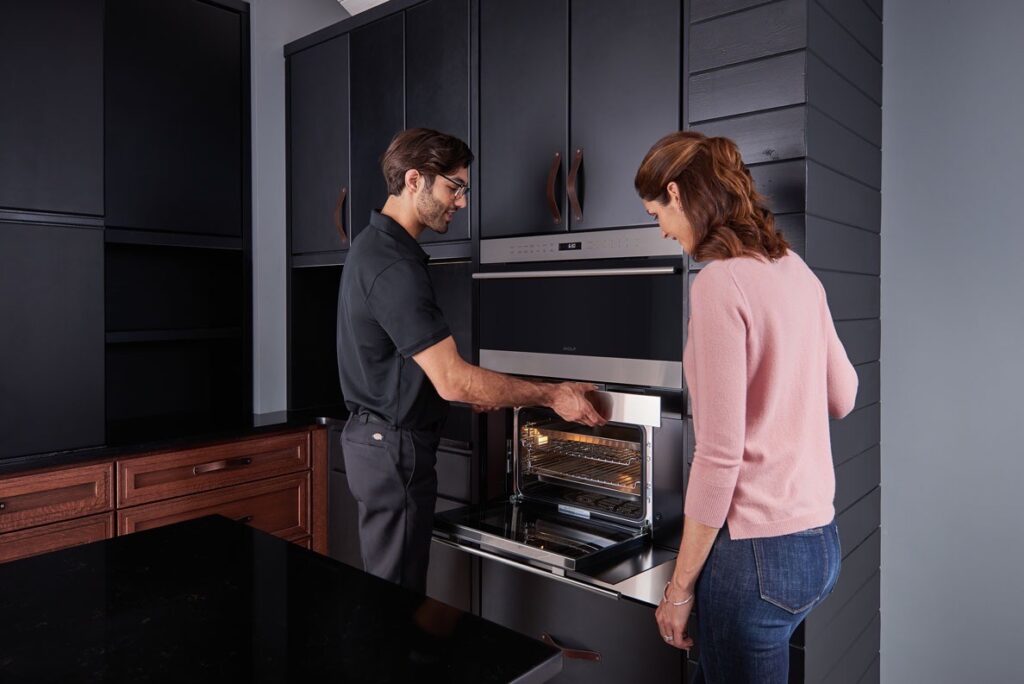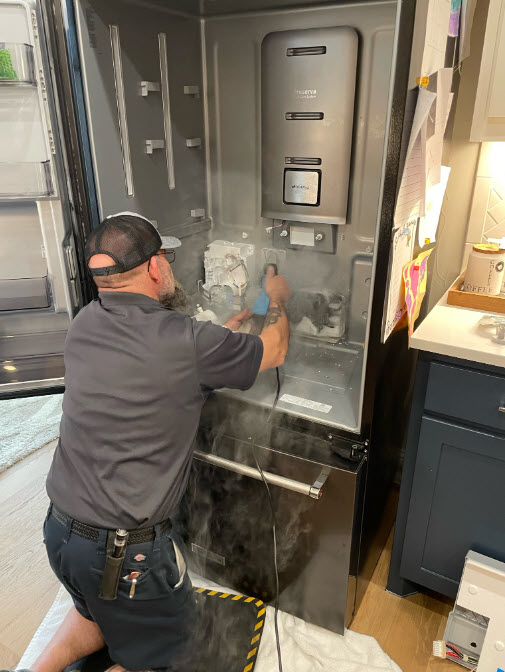How Much Is That Fridge Really Costing You? Find Out with a Call to Dependable Refrigeration Appliance SubZero repair near me
How Much Is That Fridge Really Costing You? Find Out with a Call to Dependable Refrigeration Appliance SubZero repair near me
Blog Article
The Ultimate Overview to DIY Device Fixing Methods
From fridges to dishwashers, recognizing just how to repair and fix these devices can save you time and cash. Are you all set to uncover essential techniques that will empower you to deal with repair services confidently?
Comprehending Typical Home Appliance Issues
When you rely upon your home appliances, it can be annoying when they unexpectedly quit working or act up. Comprehending common appliance problems can help you repair concerns successfully. If your refrigerator isn't cooling down, examine the temperature level setups or examine the door seal for gaps. A defective cleaning device may be because of a blocked drain filter or a busted belt.
If your oven isn't heating, faulty components or thermostat problems might be to criticize,. Dish washers usually experience troubles with water drainage, so see to it the filter is tidy and the drain hose pipe isn't kinked.
Also, pay attention for unusual noises; they frequently show mechanical problems. By recognizing these indicators, you can save time and possibly avoid expensive fixings. A little understanding goes a lengthy method in keeping your home appliances, so remain informed to keep every little thing running smoothly.
Essential Devices for Do It Yourself Repair Works
Prior to diving right into DIY home appliance repairs, it is essential to gather the right tools to ensure the procedure goes smoothly. Begin with a great set of screwdrivers, including both flathead and Phillips, as they're crucial for opening up most home appliances. You'll likewise want a set of pliers for gripping and twisting cables or tiny parts.
Don't neglect a multimeter; it helps you test electric parts and detect issues efficiently. An outlet collection comes in handy for loosening or tightening bolts, while an energy blade can be helpful for reducing cords or opening packaging.
Finally, take into consideration having a flashlight on hand to light up dark spaces inside your appliances. With these important tools, you'll be well-appointed to take on numerous repair services, saving both money and time. So, gather your equipment and prepare to roll up your sleeves!
Safety First: Preventative Measures to Take
Before you start any type of home appliance repair work, it's vital to prioritize safety and security. Ensure you use personal protective devices, separate the power source, and keep your workplace organized. These basic precautions can aid stop crashes and guarantee a smoother repair work process.

Personal Protective Devices
Security equipment is an essential part of any DIY appliance repair work project. You ought to always use security goggles to secure your eyes from dirt and particles. A strong pair of gloves will secure your hands from unsafe products and sharp edges. Take into consideration making use of a mask if you're managing chemicals or dirt, guaranteeing you breathe safely while working. Steel-toed boots are likewise a smart choice, specifically when raising hefty home appliances. Don't forget to put on lengthy sleeves and pants to protect your skin from potential injuries. By focusing on individual protective equipment, you'll greatly lower the danger of mishaps and injuries. Remember, being prepared with the best equipment keeps you safe and concentrated on completing your repair work successfully.
Power Resource Disconnection
To assure a risk-free DIY home appliance repair, separating the power source is essential. Prior to you begin any type of work, you must unplug the device or turn off the circuit breaker. This straightforward step protects against electric shocks and assurances that you can concentrate on the repair work without bothering with unexpected activation. Constantly double-check that the appliance is off by examining it with a voltage tester. If you're taking care of larger appliances, like a washing machine or dryer, ensure to secure the power cable and avoid any call with water. Remember, security! Once you're positive that the power is detached, you can with confidence wage your fixings, knowing you've taken the required precautions to shield yourself.
Workplace Organization
A well-organized job area can make all the difference in your DIY home appliance repair work project. Start by removing your office of clutter to prevent crashes and interruptions. A clean room not only improves performance however likewise maintains you risk-free while you function on your home appliance repair.
Step-by-Step Overview for Fridge Repair Works
When your refrigerator begins acting up, it can be aggravating, however dealing with the problem on your own can save you time and money. Examine for typical issues like temperature changes or uncommon noises. For a loud fridge, check the follower and verify it's not blocked.
If there's water merging inside, check the door seals for damage or dust, and commercial fridge repair tidy them if needed. For ice accumulation, clear the defrost drain. When you have actually addressed the issue, connect the fridge back in and check it for a couple of hours. If the problem persists, you might need to replace a damaged part, like the compressor or follower electric motor. Bear in mind, do not hesitate to get in touch with the guidebook or seek expert aid if needed.
Taking Care Of Cleaning Device Concerns
Much like fridges, washing machines can present their very own set of difficulties, but numerous problems can be resolved with a little bit of troubleshooting. If your device won't start, inspect the Bonuses power cable and confirm it's connected in. Next, check the door latch; a faulty latch can protect against the cycle from beginning. It might be due to international things stuck in the drum or the drainpipe pump. if you discover uncommon sounds throughout operation.
If your clothes aren't getting clean, think about the water level and detergent type; using excessive cleaning agent can develop excess suds, influencing efficiency. For leakages, check out the tubes for fractures or loose links. Tightening up these can commonly solve the problem. Regular upkeep, like cleansing the filter, can protect against many issues from arising. Keep in mind, a little troubleshooting goes a lengthy method in maintaining your cleaning device running efficiently.
Fixing Ovens and Stoves
Just how can you troubleshoot typical problems with your stove or stove? Begin by checking the power supply.
If your oven isn't heating, inspect the temperature level setups and verify the door seals snugly. If it's damaged., a defective home heating component can likewise be the wrongdoer; you may need to change it.
For uneven cooking, rotate your pans and consider using a stove thermostat to validate precise temperature whirlpool oven control board replacement levels. If you hear uncommon sounds or smell gas, transform off the home appliance right away and get in touch with a professional. By adhering to these steps, you can determine and fix numerous usual oven and stove problems effectively.
Fixing Dish Washers Facilitated
When your dish washer begins acting up, it can be aggravating, however resolving usual concerns isn't as tough as it appears. You'll learn step-by-step troubleshooting approaches that will certainly aid you determine the problem, together with the important tools you'll need to tackle repairs on your own. Allow's make repairing your dish washer a breeze!
Typical Dishwashing Machine Issues
While dishwashing machines are developed to make your life simpler, they can in some cases run into usual concerns that leave you really feeling frustrated. One constant issue is bad cleaning efficiency; this usually takes place because of clogged spray arms or dirty filters. You could likewise discover water pooling at the base, which can suggest a kinked hose pipe or a faulty drainpipe. It could be a straightforward problem with the latch device or door seal if your dishwashing machine's door will not latch. In addition, odd noises can signal worn-out elements or loose components. Finally, if you scent something odd, it could be time to inspect for food particles or a malfunctioning motor. Resolving these problems early can conserve you time and trouble in the future (Dependable Refrigeration & Appliance Repair Service Sub-Zero Appliance Repair).

Detailed Troubleshooting
Before diving into repair work, it's important to determine the particular problem your dishwashing machine is facing. If your dishwashing machine will not start, check the power supply and door latch. By methodically addressing each possible concern, you can identify the issue and take the required steps to repair it, making your dish washer feature like new again.
Important Repair Work Tools
Having the right tools at your disposal can make all the difference when fixing your dishwasher. Do not fail to remember a pail or towels for any type of water spills throughout repairs.
If you're taking on blockages, a drainpipe snake or a wet/dry vacuum cleaner will be important. You could also desire a level to ensure your dishwasher's appropriately aligned. Ultimately, safety equipment like safety glasses and gloves will certainly shield you while you work. With these essential tools, you'll be well-appointed to tackle any type of dish washer repair work challenge that comes your way.
Often Asked Concerns
Just how Do I Determine if an Appliance Deserves Repairing?
To identify if a home appliance's worth repairing, consider its age, repair service expenses, and existing worth. If fixings go beyond half the substitute cost, you might intend to purchase a new model instead.
Can I Discover Replacement Parts In Your Area for My Home Appliance?
Yes, you can typically discover replacement components in your area for your home appliance. Check hardware stores, device fixing shops, or local classifieds. Do not fail to remember to bring the model number to assure you obtain the appropriate part!
When Repairing Appliances?, what Usual Mistakes Should I Prevent.
When repairing devices, prevent hurrying with diagnostics, disregarding safety and security precautions, or using wrong tools. Do not avoid reading guidebooks or viewing tutorials; they provide crucial support. Be patient and thorough to assure effective repair services and prevent additional damage.
How Lengthy Does a Typical DIY Appliance Fixing Take?
A normal DIY home appliance fixing typically takes one to 3 hours, depending on the complexity. You'll wish to gather your products and tools first, and adhere to instructions very carefully to stay clear of unnecessary delays.
Exist Any Kind Of Warranties for DIY Home Appliance Services?
When you tackle DIY home appliance fixings, warranties normally do not cover your job. Some producers may recognize service warranties for components you change. Constantly examine your appliance's warranty terms before starting any type of repairs to avoid problems.
Before diving into DIY home appliance repair services, it's crucial to collect the right devices to ensure the procedure goes smoothly.Before you start any type of home appliance repair work, it's vital to prioritize security.To ensure a risk-free DIY appliance repair, disconnecting the power source is necessary.A well-organized job location can make all the distinction in your Do it yourself home appliance repair work project. Constantly examine your device's guarantee terms before starting any kind of fixings to stay clear of problems.
Report this page